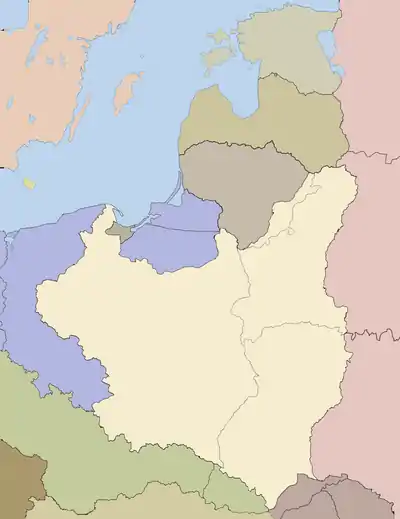Zagaje massacre
Zagaje massacre was a mass murder of ethnic Poles carried out on 11–12 July 1943 by the troops of the Ukrainian Insurgent Army group "Piwnicz", aided by the Ukrainian peasants, during the Massacres of Poles in Volhynia and Eastern Galicia.[1][2] Approximately 260–350 people were killed, including women and children. The village Zagaje was levelled out and does not exist anymore. It was located in the gmina Podberezie of the Horochów County (powiat horochowski) in the Wołyń Voivodeship of the Second Polish Republic (now, Horokhiv Raion, Ukraine).[3] Overall, in the Horochów County some 4,200 ethnic Poles were murdered,[4] in nearly hundreds of separate locations before the end of the Polish-Ukrainian conflict.[5] The village Zagaje is not to be confused with the Zagaje colony, located in gmina Czaruków, powiat Łuck, of the same voivodeship.[6]
| Zagaje massacre | |
|---|---|
| Location | Zagaje, Volhynian Voivodeship, occupied Poland |
| Coordinates | 50°30′0″N 24°47′0″E |
| Date | 11–12 July 1943 |
| Target | Poles |
Attack type | Shooting and stabbing |
| Weapons | Axes, bludgeons, bayonets |
| Deaths | 260–350 |
| Perpetrators | Ukrainian Insurgent Army |
| Motive | Anti-Catholicism, Anti-Polish sentiment, Greater Ukraine, Ukrainisation |
The massacre was committed in the course of so-called Bloody Sunday of 11 July 1943, when the OUN-UPA killing squads raided simultaneously 99 Polish villages in two counties, including powiat horochowski and powiat włodzimierski.[7] With the neighbouring powiat kowelski counted in, the number rose to 150 settlements.[8] Most victims – assembled for regular Sunday services – were murdered in Polish Catholic churches, and in their environs.[7]
References
- Władysław Filar (2008), Wydarzenia wołyńskie 1939-1945. W poszukiwaniu odpowiedzi na trudne pytania. Toruń: Wydawnictwo Adam Marszałek. ISBN 978-83-7441-884-3.
- Władysław Siemaszko, Ewa Siemaszko (2000), Ludobójstwo dokonane przez nacjonalistów ukraińskich na ludności polskiej Wołynia 1939-1945, Warszawa, p. 380.
- Strony o Wołyniu (October 2008). "Wieś Zagaje, gmina Podberezie, powiat Horochów, woj. wołyńskie". Wolyn.ovh.org.
- Wołyń naszych przodków (2016). "Powiat horochowski". NaWolyniu.pl.
Liczbę wymordowanych Polaków w powiecie horochowskim ocenia się na 4,200 osób.
- Wołyń naszych przodków (2016). "Map of Powiat horochowski showing hundreds of locations of massacres of Poles". NaWolyniu.pl.
- Strony o Wołyniu (2008). "Kolonia Zagaje, gmina Czaruków, powiat Łuck, woj. wołyńskie". Wolyn.ovh.org.
- Paweł Brojek; Joanna Wieliczka-Szarkowa; Andrzej Solak; et al. (2013). "70 rocznica Krwawej Niedzieli na Wołyniu" [The 70th anniversary of Bloody Sunday in Volhynia]. Ogólnopolski miesięcznik ODKRYWCA. With links to sourced articles.
- Lesław Sajdak, PAP (11 July 2015). "11 lipca 1943 roku - kulminacja zbrodni wołyńskiej" [11 July 1943 culmination of the Volhynian slaughter]. Dzieje.pl.
W niedzielę 11 lipca 1943 r. bandy UPA jednocześnie zaatakowały 150 miejscowości powiatów włodzimierskiego, horochowskiego i kowelskiego. Do największych masakr ludności polskiej na Wołyniu doszło w Woli Ostrowieckiej (572-620 zabitych), Ostrówkach (476-520 zabitych); w Porycku (pow. Włodzimierz, dziś Pawliwka) zamordowano 200-220 Polaków.

